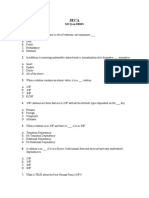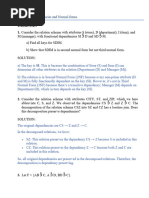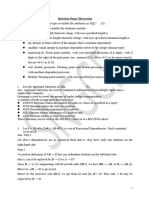Assignment Normalization
Uploaded by
ruchika.singh3001Assignment Normalization
Uploaded by
ruchika.singh3001Course Name: DBMS Course Code: E2UC302B
Assignment 3(b)
Problem based on Normalization: 1NF, 2NF, 3NF, and BCNF.
1. A relation R(A, B, C, D, E, F, G, H) and set of functional dependencies are CH → G, A → BC,B →
CFH, E → A,F → EG How many possible super keys are present ?
2. Relation R (A, B, C, D) with the following functional dependencies:
A→ B
B→C
A→D
Determine if the relation is in 1NF and 2NF. If not, decompose it to achieve 2NF.
3. Relation R (A, B, C, D) with the following functional dependencies:
A→ B
B→C
A, C → D
Determine if the relation is in 2NF and 3NF. If not, decompose it to achieve 3NF.
Solution:
4. Relation R(A, B, C, D, E) with the following functional dependencies:
A→ B
B→C
C→D
D→E
5. Determine if the relation is in 1NF, 2NF, and 3NF. If not, decompose it to achieve 3NF.
Relation R(A, B, C, D) with the following functional dependencies:
A→ B
B→C
A, D → C
6. Determine if the relation is in 2NF. If not, decompose it to achieve 2NF.
Relation R(A, B, C, D, E) with the following functional dependencies:
A→ B
B→C
A→D
D→E
7. Determine if the relation is in 3NF. If not, decompose it to achieve 3NF.
Relation R (A, B, C, D, E) with the following functional dependencies:
A→ B
B→C
C→D
A→E
8. Determine if the relation is in 2NF and 3NF. If not, decompose it to achieve 3NF.
9. Relation R (A, B, C, D, E) with the following functional dependencies:
A→ B
B→C
C→D
A, E → D
Determine if the relation is in 1NF, 2NF, and 3NF. If not, decompose it to achieve 3NF.
10. Given the relation R (A, B, C) with functional dependencies (FDs):
A→ B
B→C
Is the relation R in BCNF?
11. Consider the relation R (A, B, C, D) with the following functional dependencies:
A→B
B→C
C → D Decompose R into BCNF.
12. Given the relation R(A, B, C, D) with the following FDs:
A→ B
B→C
C→D
A→D
Determine if R is in BCNF and justify your answer.
13. Consider the relation R(a,b,c,d) with Set F={a→c,b→d} (i) Decompose this relation in 2 NF
14. Given the following set of FDs on schema R (V,W,X,Y,Z) {Z→V, W→Y, XY→Z, V→WX}State
whether the following decomposition are loss-less-join decompositions or not. (i) R1=(V,W,X) ,
R2=(V,Y,Z) (ii) R1=(V,W,X), R2=(X,Y,Z)
15. Consider the universal relation R = {A, B, C, D, E, F, G, H, I, J} and the set of functional dependencies
F = { {A, B}→{C}, {A}→{D, E}, {B}→{F}, {F}→{G,H}, {D}→{I, J} }. What is the key for R?
Decompose R into 2NF and then 3NF relations
16. What is highest normal form of the Relation R(W,X,Y,Z) with the set F= { WY → XZ, X →Y }
(ii) Consider a relation R(A,B,C,D,E) with set F= { A→CD, C→B,B→AE} What are the prime
attributes of this Relation and Decompose the given relation in 3NF.
17. Normalize the following schema, with given constraints, to 3NF.
books(accessionno, isbn, title, author, publisher) ,users(userid, name, deptid, deptname)
accessionno→isbn
isbn→title
isbn→publisher
isbn→→author
userid→name
userid→deptid
deptid→deptname
18. Suppose we have a database for an investment firm, consisting of the following attributes:
B — Broker, O — Office of a broker, I — Investor, S — Stock, Q — Quantity of stock owned by an
investor, D — dividend paid by a stock. Hence, the overall schema is R = (B, O, I, S, Q, D). Assume
that the following functional dependencies are required to hold on this:
a) List all the candidate keys for R.
b) Give a lossless-join decomposition of R into BCNF.
c) Give a lossless-join decomposition of R into 3NF preserving functional dependencies.
19. A relation R (A, B, C, D) having two FD sets FD1 = {A->B, B->C, A->C} and FD2 = {A->B, B->C, A-
>D}. Check the equivalence relation in both the functional dependencies.
20. Suppose you are given a relation R = (A, B, C, D, E) with the following functional
Dependencies: {CE → D, D → B, C → A}. Is the relationship in BCNF? If not, convert it into BCNF.
You might also like
- ACFrOgCK8d qx6yIxOeRqfBi5-IzmTuxFV3MadZ0abymeKDqroisQWmlZDwwQPkY8jB8YEEJpIT0L95cAmqXTJdTB2JK2RoQLSSJjr2ZbwFBGlFW6kWhidXcYBqRPKJtDcnlRTNyRzqkt9J3t2nnNo ratings yetACFrOgCK8d qx6yIxOeRqfBi5-IzmTuxFV3MadZ0abymeKDqroisQWmlZDwwQPkY8jB8YEEJpIT0L95cAmqXTJdTB2JK2RoQLSSJjr2ZbwFBGlFW6kWhidXcYBqRPKJtDcnlRTNyRzqkt9J3t2nn3 pages
- Database Management System 1. For A Database Relation R (A, B, C, D) Where The Domains of A, B, C and D Only Include AtomicNo ratings yetDatabase Management System 1. For A Database Relation R (A, B, C, D) Where The Domains of A, B, C and D Only Include Atomic4 pages
- 1 FDNormalForm30YearsPYQsPart12007-1993byVijayAgarwalSirNo ratings yet1 FDNormalForm30YearsPYQsPart12007-1993byVijayAgarwalSir49 pages
- Relational Database Design: Practice Exercises0% (1)Relational Database Design: Practice Exercises6 pages
- Exercise: B CD (C) AB CD (D) C D (E) B A (F) BD AC (G) AD BC (H) D B (I) D C (J) C ANo ratings yetExercise: B CD (C) AB CD (D) C D (E) B A (F) BD AC (G) AD BC (H) D B (I) D C (J) C A17 pages
- Database Management System: Assignment 4: September 2, 2018No ratings yetDatabase Management System: Assignment 4: September 2, 201810 pages
- Normalization in Database Manangement SystemNo ratings yetNormalization in Database Manangement System12 pages
- Visit:: Join Telegram To Get Instant Updates: Contact: MAIL: Instagram: Instagram: Whatsapp ShareNo ratings yetVisit:: Join Telegram To Get Instant Updates: Contact: MAIL: Instagram: Instagram: Whatsapp Share7 pages
- Lecture 6 - Entity Relationship ModelingNo ratings yetLecture 6 - Entity Relationship Modeling18 pages
- CSCE 351 Operating System Kernels: Steve GoddardNo ratings yetCSCE 351 Operating System Kernels: Steve Goddard10 pages
- Visvesvaraya Technological University: Hotel Management SystemNo ratings yetVisvesvaraya Technological University: Hotel Management System29 pages
- Checking The Data Using Extractor Checker in ECC Delta and Repea DeltaNo ratings yetChecking The Data Using Extractor Checker in ECC Delta and Repea Delta21 pages
- United States Patent: (45) Date of Patent: Mar - 26, 2019No ratings yetUnited States Patent: (45) Date of Patent: Mar - 26, 201935 pages
- Cf-Ru5102 Uhf Rfid Reader User's Manual v1.2No ratings yetCf-Ru5102 Uhf Rfid Reader User's Manual v1.236 pages
- NetApp Flash Pool and Flash Cache: A Deep DiveNo ratings yetNetApp Flash Pool and Flash Cache: A Deep Dive3 pages
- Course Student Handout Format CPT 04.01.2024No ratings yetCourse Student Handout Format CPT 04.01.202412 pages
- Math in The Modern World - Module - Final Term - Revised 1No ratings yetMath in The Modern World - Module - Final Term - Revised 172 pages































































































